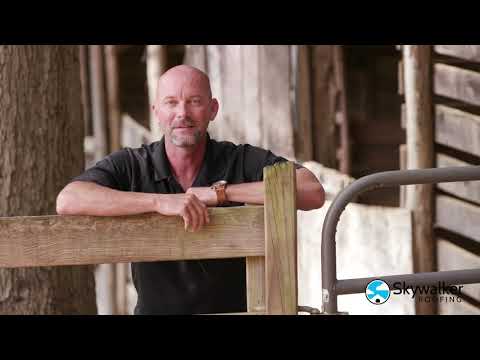A roof consists of much more than just what you see on top. A roof’s cross section includes several component layers beneath the outer roofing material. There are many important elements included in a proper roof system, like flashing, decking, insulation, and ventilation. And another of those important layers which typically goes unseen is the underlayment.
What’s underlayment? It’s essentially a layer of water-resistant material installed between the decking and the outer roofing which is primarily intended to serve as a vapor barrier. A sound underlayment prevents water from penetrating and can also be designed to help allow internal moisture to escape. Underlayment comes in various material options, but these three are some of the most popular:
· Felt Underlayment
· Self-Adhesive Membrane
· Synthetic Sheet Underlayment
What’s the Difference Between Underlayment Options?
Because there are different options when it comes to roofing underlayment solutions, it’s helpful to know more details, and to be able to understand the pros and cons of each approach. Let’s take a closer look at each of the underlayment materials we mentioned above.
Felt Underlayment
It’s commonly known by names like felt paper, tar paper, and asphalt-soaked felt. By any name, felt underlayment has been a staple for roofs of all shapes and sizes for decades.
The advantages of asphalt felt:
· It’s generally the cheapest option.
· Due to a base which typically includes asphalt, felt paper is reliably water-repellent.
· Because felt is so popular and so common, you can get it practically anywhere.
The disadvantages of asphalt felt:
· It’s not nearly as long-lasting as some other materials.
· It doesn’t endure high-temperature environments particularly well.
· It isn’t the most effective underlayment material for roofs that are considered to be low-slope.
Self-Adhesive Membrane Underlayment
Self-adhesive underlayment is a special type of peel-and-stick product designed to attack directly to the roof decking, underneath the outer layer of roofing material. This membrane often consists of either rubberized asphalt or butyl-based adhesive which goes over a polyethylene carrier sheet. And there are certainly some things to like about self-adhesive membranes.
The advantages of self-adhesive membrane:
· Self-adhesive membrane is known to be effective for ice dam protection in sensitive areas like roof eaves, rising walls, valleys, and dormers.
· It performs much better in high-temperature environments than tar paper.
· It provides an additional air barrier to go along the vapor barrier.
The disadvantages of self-adhesive membrane:
· While self-adhesive membrane responds well to high temperatures, it does not handle low-temperature conditions very well.
· It can be more challenging to install self-adhesive membrane properly, since it’s innately more “sticky.” A botched installation can result in membrane which eventually peels back, and ultimately shortens the service life of your product as well.
· Self-adhesive membrane isn’t the most expensive option, but it does typically cost more than felt underlayment.
Synthetic Sheet Underlayment
Synthetic underlayment sheeting is a more recent roofing innovation that’s quickly becoming more prevalent. It’s typically comprised of polyethylene or polypropylene polymer fibres which are woven or spun together to form a protective barrier between the decking and the outer composite roofing material. And the list of advantages for synthetic sheeting are many.
The advantages of synthetic sheet underlayment:
· Synthetic sheeting is incredibly durable, thanks to the use of thermoplastic polymers; these are very resistant to impacts and tears. Synthetic is known to be the longest lasting among popular underlayment options.
· Synthetic is very tolerant of high temperatures.
· It’s also an incredibly effective moisture barrier.
The disadvantages of synthetic sheet underlayment:
· It’s so effective at keeping out moisture, that synthetic underlayment isn’t always the best vapor barrier in terms of allowing internal moisture to escape. However, this really shouldn’t be an issue as long as you have a proper roof ventilation system in place.
· Synthetic is often the most expensive underlayment material option. But this should be offset by the fact that synthetic also offers the most reliable performance and provides the best material longevity.
Do You Even Need Any Underlayment for a Metal Roof?
Good question! While a vapor barrier may not necessarily be an essential requirement for maintaining a metal roof’s structural integrity of a metal roof, there are other factors to bear in mind. Having the right underlayment in place still helps to prevent moisture from infiltrating your home, business, or storage facility, and effective underlayment should also help prevent condensation from forming inside your building’s interior. And no matter which outer roofing material you go with, entrapped moisture can accelerate the deterioration of any roof. It’s a good idea to choose an underlayment that’s designed to pair well with your chosen outer roofing material (metal or otherwise), to better promote the longevity of your roof system as a whole.
Choose Trusted Roofing Contractors for Your Roofing Solution in your area
Now that you know more about the importance of underlayment to a proper roofing system, hopefully you’re better prepared for moving forward with your roofing solution plan. And if you’re looking for a reputable roofing partner with a service area which includes significant regions in United States. Please follow this blog you can get the best roofing contractors in your area.
